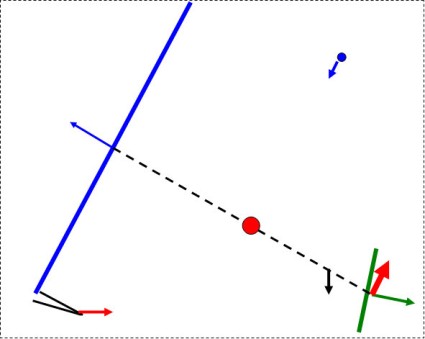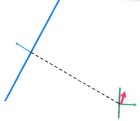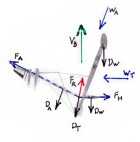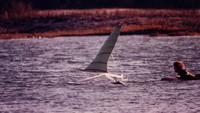High-Speed Sailing
| Vessel Name: | Sailien |
| Vessel Make/Model: | Experimental/custom |
28 September 2013
The America’s Cup
I watched, with interest, the videos of the 34th America’s Cup. At last we have fast sailboats engaged in a competition that is fun to watch. The virtual images (such as course boundaries, distance grid lines, separation between boats, etc.) overlaid on the real images really helps to keep the race [...]
31 August 2013
100 Knots for Hydroptere?
The latest news from Hydroptere is that they have plans for a 100 knot sailboat. This was posted on 26 Aug 2013, so look for that date at this address. http://hydroptere.com/en/the-news/last-news/
17 November 2012
Aptly named Sailrocket, blasts off!
While yet to be ratified, Sailrocket posted an average speed over 500 meters of 59 knots. I will not be surprised if they increase their record into the 60 knot range during this record attempt.
02 January 2012
More drag for VSR2?
I want to start by pointing out that the whole VSR2 team has done a stellar job and has demonstrated conclusively that the forces that drive a sailboat can be aligned for roll stability without using ballast and without using any down-force. (Trifoiler achieved roll stability by using down-force, but [...]
18 December 2011
My analysis of Sailrocket
I copied a diagram of VSR2 (wing doesn’t show well) and added in the major force arrows that apply. Be aware that these arrows are not correct in terms of scale (length) and some of their locations are guesses, however I believe I’m correct enough for us to learn something about what VSR2 has been [...]
23 October 2011
60 is within reach, what’s next?
I have been watching Sailrocket’s progress with great interest and there’s no question they have a winner. I fully expect to see them reach 60kt in the near future. Sailrocket has now demonstrated what I first learned with my models and again with my full-sized prototypes, that if you get the forces [...]
More about Sailrocket's air

Now the fun begins: note that the windward hydrofoil is not parallel to the airfoil and its lift arrow is not in line with the dashed line. This is the situation Sailrocket encountered when the foil mount failed, causing the hydrofoil to become more vertical. The bold red arrow represents the resultant force from the airfoil's lift and from the hydrofoil's lift. I believe this is the force that launched the nose of Sailrocket. Once the nose was up, the angle of attack on the cross-arm wing was great enough to overcome the down-force generated by the flaps, and Sailrocket took off.
If you look carefully at Sailrocket's video of the last flip you can see the craft hit a small wave; the nose bumps up and drops back down. That wave did not launch the boat; was there a second wave? I cannot tell from the video, but unless the second wave was larger than the first, it would not have launched the boat either. I suspect the launch was not wave related but was totally due to the hydrofoil coming loose, changing its angle and thereby forcing the nose up.
Did the foil break loose because the load (center of effort) shifted lower on the foil because the wave bounced the top section out of the water? No, if the top section of the foil came out of the water, the total force the foil was generating would have lessened, decreasing the force on the mounting point. The only way the foil load could have increased, would have been if the velocity increased or the angle of attack increased and I believe that inertia rules that out (considering the short time span between the first wave and the launch).
If the first wave had any bearing on the launch, I suspect that the shock load from hitting it caused the already over-stressed foil mount to fail. The foil mount may not have been strong enough to begin with or it may have been damaged previously and that damage went undetected.
One more point I'd like to make. Many think that the inclined airfoil is creating an up-force on the craft and that the inclined hydrofoil is creating a down-force on the craft. In fact there is no up-force or down-force from those two lift forces. As long as the lift forces are in alignment, they cancel out and the craft does not "feel" them (except as a tension between the two foils). What counts is the resultant between those two lift forces, it should be zero, but if the alignment goes out, the resultant increases and the direction it points is the direction the parts are going to move. To fully understand what's going on you must account for all the forces involved and how they interrelate. This is a lot easier than most think since we only need to track the major forces (which I've been describing).
Bob
About & Links
- Bob's Surfing Blog
- Bob's Website
- Greenbird (Windjet)
- l'Hydroptere
- Le Projet Dared
- Macquarie Speed Sailing Team
- Monofoil Sailing
- Mountain Goat STOL
- Mr Smith's Amazing Sailboats
- Patent Office (Search)
- Radboat
- Sailien Prototypes (early), Delta, etc.
- Sailien Video
- Sailien Website
- The Basics of Surfboard Design
- The Basics of Surfboard Design en Espanol
- The Swedish Speed-Sailing Challenge
- Trifoiler
- Vestas Sailrocket
- Windjet Project
- WSSRC


